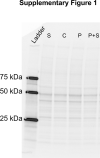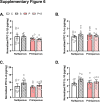Gestational stress decreases postpartum mitochondrial respiration in the prefrontal cortex of female rats
- PMID: 37654512
- PMCID: PMC10466928
- DOI: 10.1016/j.ynstr.2023.100563
Gestational stress decreases postpartum mitochondrial respiration in the prefrontal cortex of female rats
Abstract
Postpartum depression (PPD) is a major psychiatric complication of childbirth, affecting up to 20% of mothers, yet remains understudied. Mitochondria, dynamic organelles crucial for cell homeostasis and energy production, share links with many of the proposed mechanisms underlying PPD pathology. Brain mitochondrial function is affected by stress, a major risk factor for development of PPD, and is linked to anxiety-like and social behaviors. Considering the importance of mitochondria in regulating brain function and behavior, we hypothesized that mitochondrial dysfunction is associated with behavioral alterations in a chronic stress-induced rat model of PPD. Using a validated and translationally relevant chronic mild unpredictable stress paradigm during late gestation, we induced PPD-relevant behaviors in adult postpartum Wistar rats. In the mid-postpartum, we measured mitochondrial function in the prefrontal cortex (PFC) and nucleus accumbens (NAc) using high-resolution respirometry. We then measured protein expression of mitochondrial complex proteins and 4-hydroxynonenal (a marker of oxidative stress), and Th1/Th2 cytokine levels in PFC and plasma. We report novel findings that gestational stress decreased mitochondrial function in the PFC, but not the NAc of postpartum dams. However, in groups controlling for the effects of either stress or parity alone, no differences in mitochondrial respiration measured in either brain regions were observed compared to nulliparous controls. This decrease in PFC mitochondrial function in stressed dams was accompanied by negative behavioral consequences in the postpartum, complex-I specific deficits in protein expression, and increased Tumor Necrosis Factor alpha cytokine levels in plasma and PFC. Overall, we report an association between PFC mitochondrial respiration, PPD-relevant behaviors, and inflammation following gestational stress, highlighting a potential role for mitochondrial function in postpartum health.
Keywords: Chronic unpredictable stress; Mitochondria; Postpartum; Prefrontal cortex; Pregnancy; Susceptibility.
Conflict of interest statement
The authors have no competing interests or conflict to declare.
Figures













Similar articles
-
The effects of gestational stress and Selective Serotonin reuptake inhibitor antidepressant treatment on structural plasticity in the postpartum brain--A translational model for postpartum depression.Horm Behav. 2016 Jan;77:124-31. doi: 10.1016/j.yhbeh.2015.05.005. Epub 2015 May 18. Horm Behav. 2016. PMID: 25997412 Free PMC article.
-
Gestational stress induces persistent depressive-like behavior and structural modifications within the postpartum nucleus accumbens.Eur J Neurosci. 2014 Dec;40(12):3766-73. doi: 10.1111/ejn.12752. Epub 2014 Oct 31. Eur J Neurosci. 2014. PMID: 25359225 Free PMC article.
-
Mitochondrial gene signature in the prefrontal cortex for differential susceptibility to chronic stress.Sci Rep. 2020 Oct 27;10(1):18308. doi: 10.1038/s41598-020-75326-9. Sci Rep. 2020. PMID: 33110158 Free PMC article.
-
Emerging roles of brain metabolism in cognitive impairment and neuropsychiatric disorders.Neurosci Biobehav Rev. 2022 Nov;142:104892. doi: 10.1016/j.neubiorev.2022.104892. Epub 2022 Sep 28. Neurosci Biobehav Rev. 2022. PMID: 36181925 Review.
-
[GABAergic approach of postpartum depression: A translational review of literature].Encephale. 2020 Apr;46(2):123-134. doi: 10.1016/j.encep.2019.09.007. Epub 2019 Nov 22. Encephale. 2020. PMID: 31767256 French.
Cited by
-
Gestational stress disrupts dopamine and oxytocin signaling in the postpartum reward system of rats: implications for mood, motivation and mothering.Sci Rep. 2025 Jan 9;15(1):1450. doi: 10.1038/s41598-024-84043-6. Sci Rep. 2025. PMID: 39789137 Free PMC article.
-
Bridging Neurobiological Insights and Clinical Biomarkers in Postpartum Depression: A Narrative Review.Int J Mol Sci. 2024 Aug 14;25(16):8835. doi: 10.3390/ijms25168835. Int J Mol Sci. 2024. PMID: 39201521 Free PMC article. Review.
-
Mitochondrial might: powering the peripartum for risk and resilience.Front Behav Neurosci. 2023 Dec 20;17:1286811. doi: 10.3389/fnbeh.2023.1286811. eCollection 2023. Front Behav Neurosci. 2023. PMID: 38187925 Free PMC article. Review.
-
A Skeletal Muscle-Mediated Anticontractile Response on Vascular Tone: Unraveling the Lactate-AMPK-NOS1 Pathway in Femoral Arteries.Function (Oxf). 2024 Nov 20;5(6):zqae042. doi: 10.1093/function/zqae042. Function (Oxf). 2024. PMID: 39289003 Free PMC article.
-
Voluntary wheel running as a promising strategy to promote autonomic resilience to social stress in females: Vagal tone lies at the heart of the matter.Auton Neurosci. 2024 Jun;253:103175. doi: 10.1016/j.autneu.2024.103175. Epub 2024 Apr 15. Auton Neurosci. 2024. PMID: 38677130 Free PMC article. Review.
References
LinkOut - more resources
Full Text Sources
Miscellaneous

